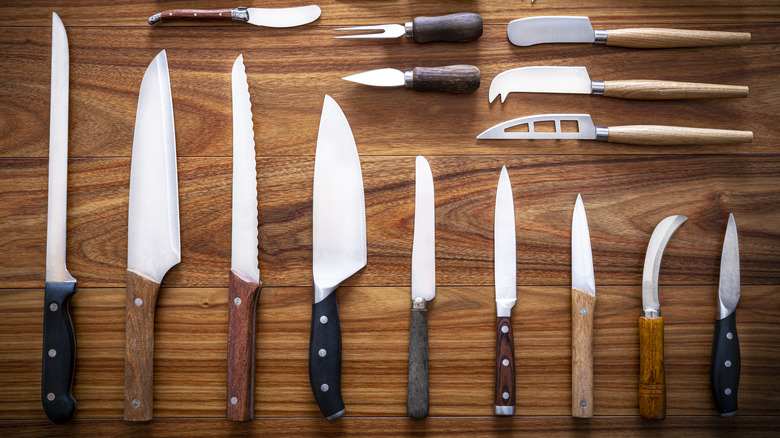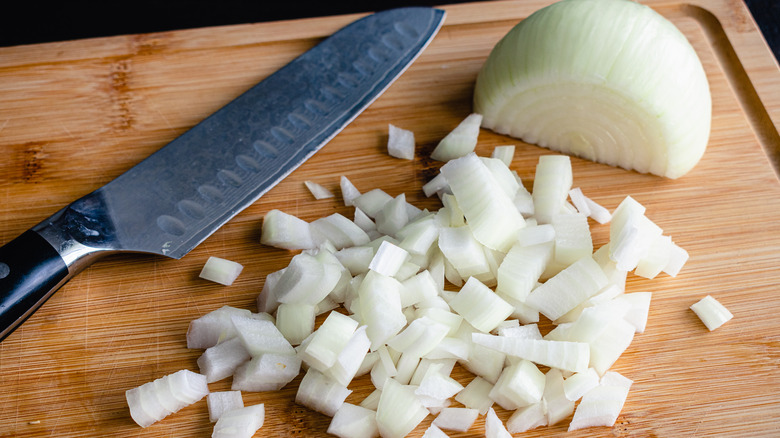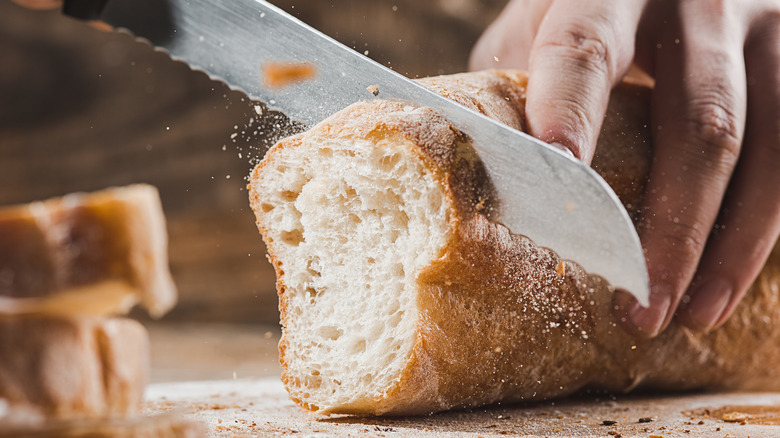The Only 3 Knives You Need In Your Kitchen Arsenal
A knife is a knife, just so it slices, dices, and chops your food quickly and easily — right? If only it were that simple. Plenty of professional and home-kitchen chefs adamantly advocate for proper knife selection, often matched to the task at hand. The type of food being prepared plays a big role in choosing a knife, as does the intended plate-bound outcome. Even a single meal component, such as meat, bread, or vegetable, will meet the knife in different ways, largely dependent on how it will be cooked or served.
Though everyday and specialty kitchen-knife varieties abound across the globe, roughly a dozen dominate in Western-style food preparation. But only three rise to the status of multifunctional, essential, gotta-have culinary tools. With some leeway for personal preference, the universally accepted big three blades for the kitchen are a chef's knife, a serrated knife, and a paring knife.
Each of these three knives can carry slightly different features within their category, depending on the manufacturer — but they pretty much serve similar functions in the kitchen or at your table. And they tend to have comparable characteristics when it comes to length, composition, weight, blade strength, and details.
The essential chef's knife
The all-important chef's knife is the ultimate kitchen staple and is considered the most crucial culinary implement for any chef. Its wide blade and generous length of 6 to 10 inches make it perfect for chopping a range of foods. A gradual upward blade curve facilitates the gentle rocking motion for precise mincing and dicing, and a good knife will have a balanced weight between the blade and handle to help avoid hand fatigue.
The metal used in the blade construction makes a difference in several regards. High-carbon steel blades provide a sharper cut but can chip or corrode over time, requiring more maintenance and care. Chef's knives made from high-alloy stainless steel are sturdy workhorses but may feel heavy-handed for extended chopping chores.
Many high-quality chef's knives originate from international bladesmiths, particularly ones in Germany, Japan, and France. Though they're all essentially chef's knives, style variations differentiate them somewhat. For example, a Japanese version, referred to as a Santoku knife, may have a shorter blade with a downward-curving tip — while the tip curves upward in its French-style counterpart. German knives are known for what's called a full-tang construction using a single piece of steel throughout the entire blade — sturdy but heavy.
Myriad details define a chef's knife, so it's best to find a balance of style and features that meet your own proclivities. The same goes for the other two knives in the top-three must-have category, despite being lower in the overall kitchen-tool hierarchy.
What to know about paring and serrated knives
When it comes to blade materials, durability, handles, and quality in paring and serrated knives, take a page from the chef's knife considerations. It all comes down to personal preference as well as budgetary concerns. We've all experienced a jaw-drop or two when browsing knife choices in high-end kitchen stores. With these other two important kitchen knives, the focus is more on functionality for specific uses.
A paring knife is invaluable for precise food prep. Just think of all the times you need to peel apples for a feel-good pie, trim away potato skins for creamy mashes, dice fresh garlic bulbs, or slice tender strawberries. This little hand-size wonder, usually a maximum of four inches long, gives the user manageable control for smaller jobs.
A serrated knife is often called a bread knife for justifiable reasons. Many chefs pull out this long, toothy tool only when slicing into a fresh loaf of artisan or country-style bread. A hard outer crust needs the saw-tooth indentions of a serrated knife, but the inner bread has what's known as a crumb structure –– which can be damaged if standard smooth-edged knives try to maneuver through fluffy or soft textures. The serrated edges of this knife mitigate that potential damage.
Serrated knives also work well for sawing through thick-skinned melons or anything with a hard exterior and soft interior. Smaller versions, sometimes referred to as micro-serrated or tomato knives, are useful for cutting steaks or slicing waxy-skinned vegetables and fruits.



